Analysis of the Incident Management Framework and Response Procedures
VerifiedAdded on 2023/01/12
|10
|2170
|73
Report
AI Summary
This report provides a comprehensive analysis of the Incident Management Framework and Response Procedures, focusing on emergency planning and the roles of various public services. It begins by outlining the current legislation, including the Civil Contingencies Act 2004, and detailing the responsibilities of police, fire services, the NHS, and the military in emergency situations. The report then examines the Joint Emergency Services Interoperability Programme (JESIP) and analyzes the roles and responsibilities of different agencies during major incidents, emphasizing the importance of collaboration and coordination. Furthermore, the report identifies and assesses the main planning steps, based on the Joint Decision Model, that need to be considered when responding to an incident, highlighting the significance of data collection, risk assessment, decision-making, and information dissemination. The report concludes by summarizing the key findings and emphasizing the importance of preparedness and effective incident management to minimize loss and damage.

Analysing the Incident
Management Framework
and Response procedures
Management Framework
and Response procedures
Paraphrase This Document
Need a fresh take? Get an instant paraphrase of this document with our AI Paraphraser

Table of Contents
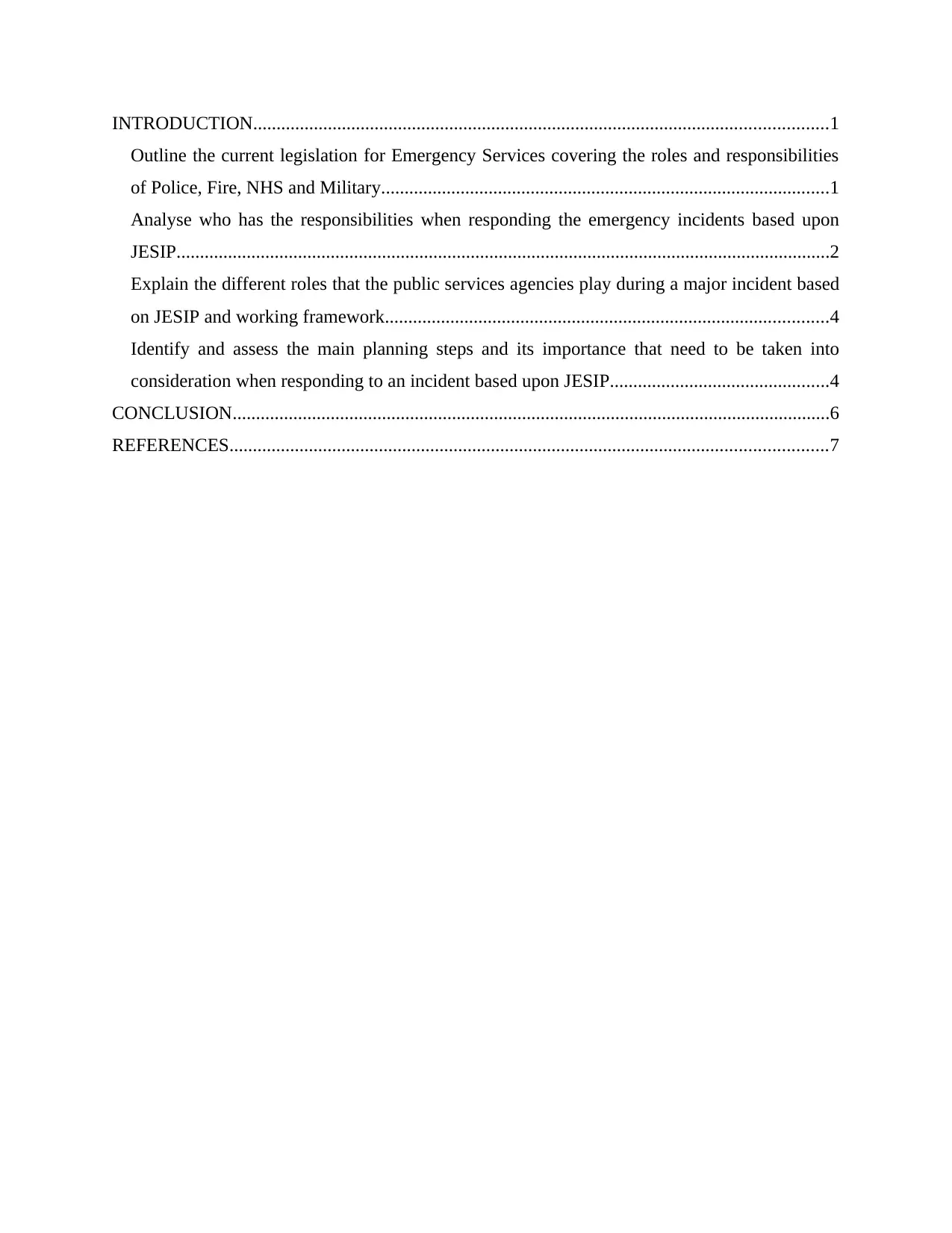
INTRODUCTION...........................................................................................................................1
Outline the current legislation for Emergency Services covering the roles and responsibilities
of Police, Fire, NHS and Military................................................................................................1
Analyse who has the responsibilities when responding the emergency incidents based upon
JESIP............................................................................................................................................2
Explain the different roles that the public services agencies play during a major incident based
on JESIP and working framework...............................................................................................4
Identify and assess the main planning steps and its importance that need to be taken into
consideration when responding to an incident based upon JESIP...............................................4
CONCLUSION................................................................................................................................6
REFERENCES................................................................................................................................7
Outline the current legislation for Emergency Services covering the roles and responsibilities
of Police, Fire, NHS and Military................................................................................................1
Analyse who has the responsibilities when responding the emergency incidents based upon
JESIP............................................................................................................................................2
Explain the different roles that the public services agencies play during a major incident based
on JESIP and working framework...............................................................................................4
Identify and assess the main planning steps and its importance that need to be taken into
consideration when responding to an incident based upon JESIP...............................................4
CONCLUSION................................................................................................................................6
REFERENCES................................................................................................................................7
⊘ This is a preview!⊘
Do you want full access?
Subscribe today to unlock all pages.

Trusted by 1+ million students worldwide
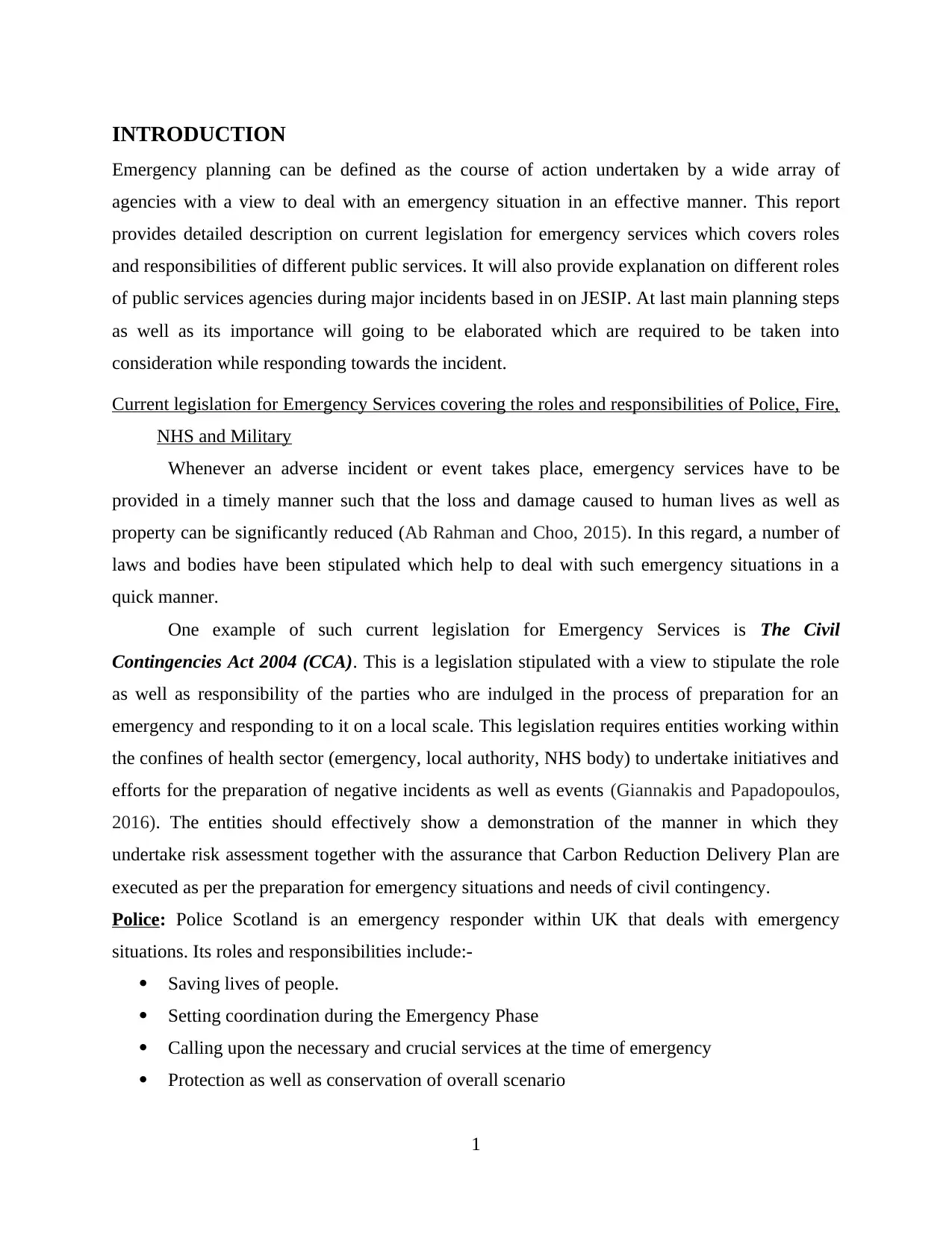
INTRODUCTION
Emergency planning can be defined as the course of action undertaken by a wide array of
agencies with a view to deal with an emergency situation in an effective manner. This report
provides detailed description on current legislation for emergency services which covers roles
and responsibilities of different public services. It will also provide explanation on different roles
of public services agencies during major incidents based in on JESIP. At last main planning steps
as well as its importance will going to be elaborated which are required to be taken into
consideration while responding towards the incident.
Current legislation for Emergency Services covering the roles and responsibilities of Police, Fire,
NHS and Military
Whenever an adverse incident or event takes place, emergency services have to be
provided in a timely manner such that the loss and damage caused to human lives as well as
property can be significantly reduced (Ab Rahman and Choo, 2015). In this regard, a number of
laws and bodies have been stipulated which help to deal with such emergency situations in a
quick manner.
One example of such current legislation for Emergency Services is The Civil
Contingencies Act 2004 (CCA). This is a legislation stipulated with a view to stipulate the role
as well as responsibility of the parties who are indulged in the process of preparation for an
emergency and responding to it on a local scale. This legislation requires entities working within
the confines of health sector (emergency, local authority, NHS body) to undertake initiatives and
efforts for the preparation of negative incidents as well as events (Giannakis and Papadopoulos,
2016). The entities should effectively show a demonstration of the manner in which they
undertake risk assessment together with the assurance that Carbon Reduction Delivery Plan are
executed as per the preparation for emergency situations and needs of civil contingency.
Police: Police Scotland is an emergency responder within UK that deals with emergency
situations. Its roles and responsibilities include:-
Saving lives of people.
Setting coordination during the Emergency Phase
Calling upon the necessary and crucial services at the time of emergency
Protection as well as conservation of overall scenario
1
Emergency planning can be defined as the course of action undertaken by a wide array of
agencies with a view to deal with an emergency situation in an effective manner. This report
provides detailed description on current legislation for emergency services which covers roles
and responsibilities of different public services. It will also provide explanation on different roles
of public services agencies during major incidents based in on JESIP. At last main planning steps
as well as its importance will going to be elaborated which are required to be taken into
consideration while responding towards the incident.
Current legislation for Emergency Services covering the roles and responsibilities of Police, Fire,
NHS and Military
Whenever an adverse incident or event takes place, emergency services have to be
provided in a timely manner such that the loss and damage caused to human lives as well as
property can be significantly reduced (Ab Rahman and Choo, 2015). In this regard, a number of
laws and bodies have been stipulated which help to deal with such emergency situations in a
quick manner.
One example of such current legislation for Emergency Services is The Civil
Contingencies Act 2004 (CCA). This is a legislation stipulated with a view to stipulate the role
as well as responsibility of the parties who are indulged in the process of preparation for an
emergency and responding to it on a local scale. This legislation requires entities working within
the confines of health sector (emergency, local authority, NHS body) to undertake initiatives and
efforts for the preparation of negative incidents as well as events (Giannakis and Papadopoulos,
2016). The entities should effectively show a demonstration of the manner in which they
undertake risk assessment together with the assurance that Carbon Reduction Delivery Plan are
executed as per the preparation for emergency situations and needs of civil contingency.
Police: Police Scotland is an emergency responder within UK that deals with emergency
situations. Its roles and responsibilities include:-
Saving lives of people.
Setting coordination during the Emergency Phase
Calling upon the necessary and crucial services at the time of emergency
Protection as well as conservation of overall scenario
1
Paraphrase This Document
Need a fresh take? Get an instant paraphrase of this document with our AI Paraphraser
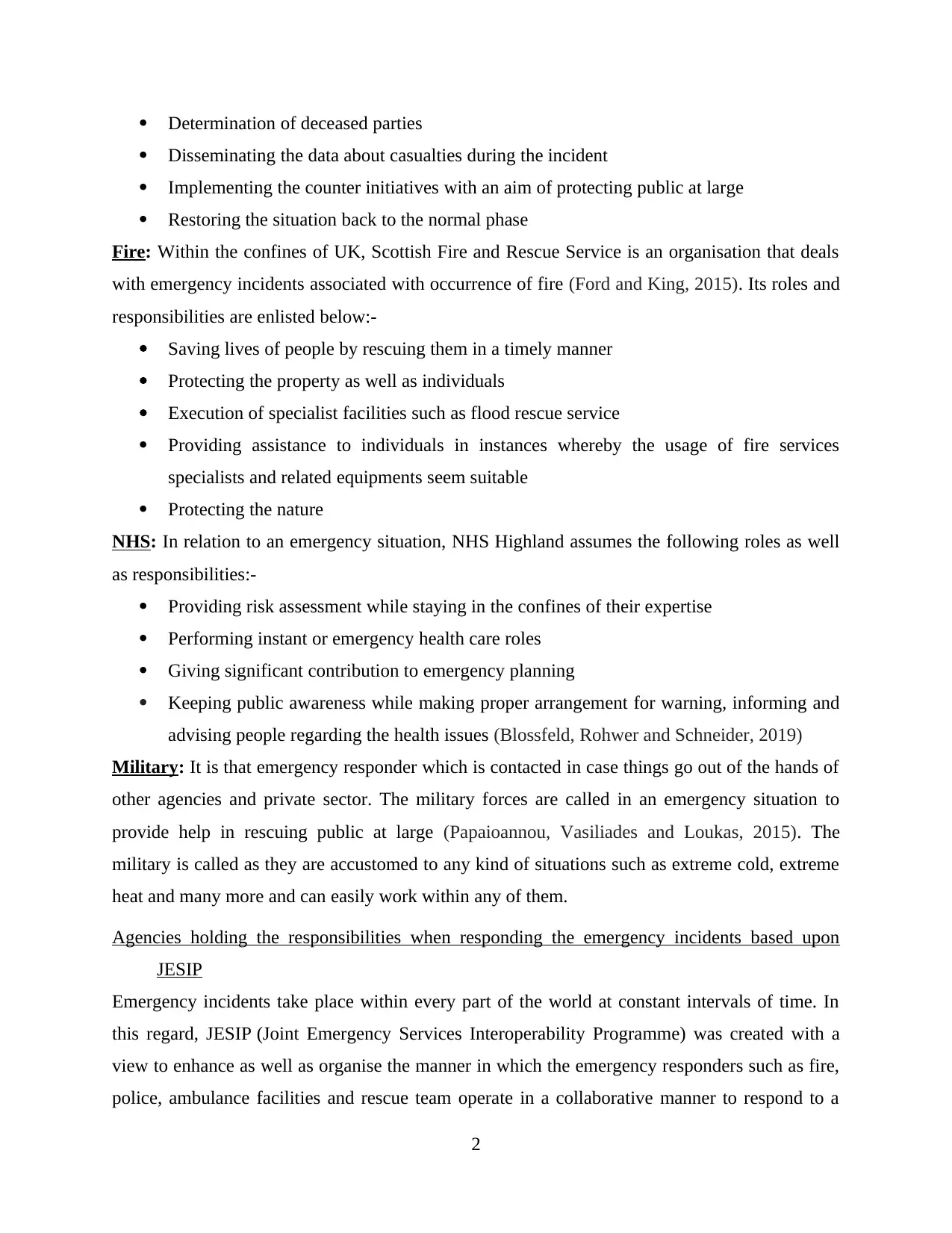
Determination of deceased parties
Disseminating the data about casualties during the incident
Implementing the counter initiatives with an aim of protecting public at large
Restoring the situation back to the normal phase
Fire: Within the confines of UK, Scottish Fire and Rescue Service is an organisation that deals
with emergency incidents associated with occurrence of fire (Ford and King, 2015). Its roles and
responsibilities are enlisted below:-
Saving lives of people by rescuing them in a timely manner
Protecting the property as well as individuals
Execution of specialist facilities such as flood rescue service
Providing assistance to individuals in instances whereby the usage of fire services
specialists and related equipments seem suitable
Protecting the nature
NHS: In relation to an emergency situation, NHS Highland assumes the following roles as well
as responsibilities:-
Providing risk assessment while staying in the confines of their expertise
Performing instant or emergency health care roles
Giving significant contribution to emergency planning
Keeping public awareness while making proper arrangement for warning, informing and
advising people regarding the health issues (Blossfeld, Rohwer and Schneider, 2019)
Military: It is that emergency responder which is contacted in case things go out of the hands of
other agencies and private sector. The military forces are called in an emergency situation to
provide help in rescuing public at large (Papaioannou, Vasiliades and Loukas, 2015). The
military is called as they are accustomed to any kind of situations such as extreme cold, extreme
heat and many more and can easily work within any of them.
Agencies holding the responsibilities when responding the emergency incidents based upon
JESIP
Emergency incidents take place within every part of the world at constant intervals of time. In
this regard, JESIP (Joint Emergency Services Interoperability Programme) was created with a
view to enhance as well as organise the manner in which the emergency responders such as fire,
police, ambulance facilities and rescue team operate in a collaborative manner to respond to a
2
Disseminating the data about casualties during the incident
Implementing the counter initiatives with an aim of protecting public at large
Restoring the situation back to the normal phase
Fire: Within the confines of UK, Scottish Fire and Rescue Service is an organisation that deals
with emergency incidents associated with occurrence of fire (Ford and King, 2015). Its roles and
responsibilities are enlisted below:-
Saving lives of people by rescuing them in a timely manner
Protecting the property as well as individuals
Execution of specialist facilities such as flood rescue service
Providing assistance to individuals in instances whereby the usage of fire services
specialists and related equipments seem suitable
Protecting the nature
NHS: In relation to an emergency situation, NHS Highland assumes the following roles as well
as responsibilities:-
Providing risk assessment while staying in the confines of their expertise
Performing instant or emergency health care roles
Giving significant contribution to emergency planning
Keeping public awareness while making proper arrangement for warning, informing and
advising people regarding the health issues (Blossfeld, Rohwer and Schneider, 2019)
Military: It is that emergency responder which is contacted in case things go out of the hands of
other agencies and private sector. The military forces are called in an emergency situation to
provide help in rescuing public at large (Papaioannou, Vasiliades and Loukas, 2015). The
military is called as they are accustomed to any kind of situations such as extreme cold, extreme
heat and many more and can easily work within any of them.
Agencies holding the responsibilities when responding the emergency incidents based upon
JESIP
Emergency incidents take place within every part of the world at constant intervals of time. In
this regard, JESIP (Joint Emergency Services Interoperability Programme) was created with a
view to enhance as well as organise the manner in which the emergency responders such as fire,
police, ambulance facilities and rescue team operate in a collaborative manner to respond to a
2
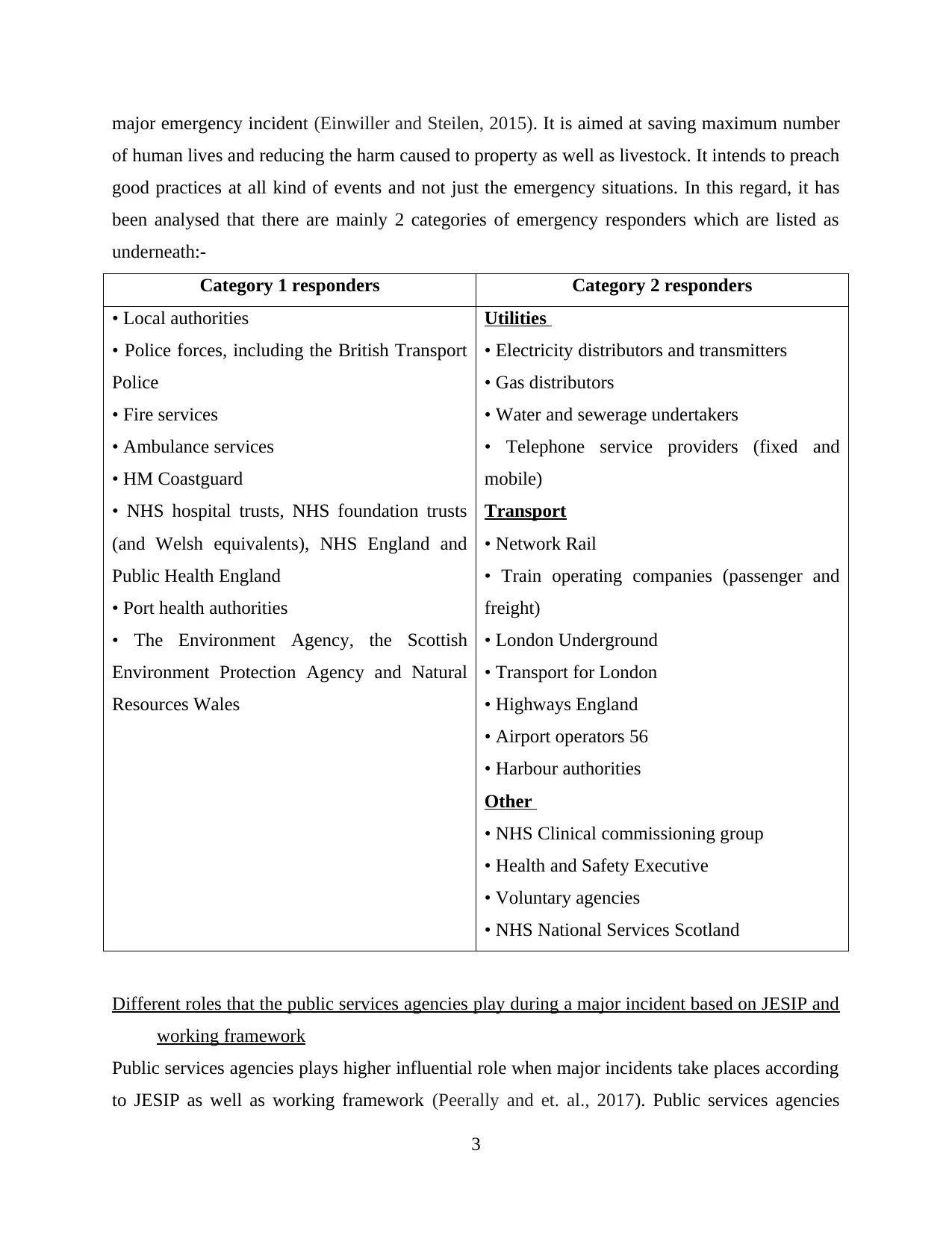
major emergency incident (Einwiller and Steilen, 2015). It is aimed at saving maximum number
of human lives and reducing the harm caused to property as well as livestock. It intends to preach
good practices at all kind of events and not just the emergency situations. In this regard, it has
been analysed that there are mainly 2 categories of emergency responders which are listed as
underneath:-
Category 1 responders Category 2 responders
• Local authorities
• Police forces, including the British Transport
Police
• Fire services
• Ambulance services
• HM Coastguard
• NHS hospital trusts, NHS foundation trusts
(and Welsh equivalents), NHS England and
Public Health England
• Port health authorities
• The Environment Agency, the Scottish
Environment Protection Agency and Natural
Resources Wales
Utilities
• Electricity distributors and transmitters
• Gas distributors
• Water and sewerage undertakers
• Telephone service providers (fixed and
mobile)
Transport
• Network Rail
• Train operating companies (passenger and
freight)
• London Underground
• Transport for London
• Highways England
• Airport operators 56
• Harbour authorities
Other
• NHS Clinical commissioning group
• Health and Safety Executive
• Voluntary agencies
• NHS National Services Scotland
Different roles that the public services agencies play during a major incident based on JESIP and
working framework
Public services agencies plays higher influential role when major incidents take places according
to JESIP as well as working framework (Peerally and et. al., 2017). Public services agencies
3
of human lives and reducing the harm caused to property as well as livestock. It intends to preach
good practices at all kind of events and not just the emergency situations. In this regard, it has
been analysed that there are mainly 2 categories of emergency responders which are listed as
underneath:-
Category 1 responders Category 2 responders
• Local authorities
• Police forces, including the British Transport
Police
• Fire services
• Ambulance services
• HM Coastguard
• NHS hospital trusts, NHS foundation trusts
(and Welsh equivalents), NHS England and
Public Health England
• Port health authorities
• The Environment Agency, the Scottish
Environment Protection Agency and Natural
Resources Wales
Utilities
• Electricity distributors and transmitters
• Gas distributors
• Water and sewerage undertakers
• Telephone service providers (fixed and
mobile)
Transport
• Network Rail
• Train operating companies (passenger and
freight)
• London Underground
• Transport for London
• Highways England
• Airport operators 56
• Harbour authorities
Other
• NHS Clinical commissioning group
• Health and Safety Executive
• Voluntary agencies
• NHS National Services Scotland
Different roles that the public services agencies play during a major incident based on JESIP and
working framework
Public services agencies plays higher influential role when major incidents take places according
to JESIP as well as working framework (Peerally and et. al., 2017). Public services agencies
3
⊘ This is a preview!⊘
Do you want full access?
Subscribe today to unlock all pages.

Trusted by 1+ million students worldwide
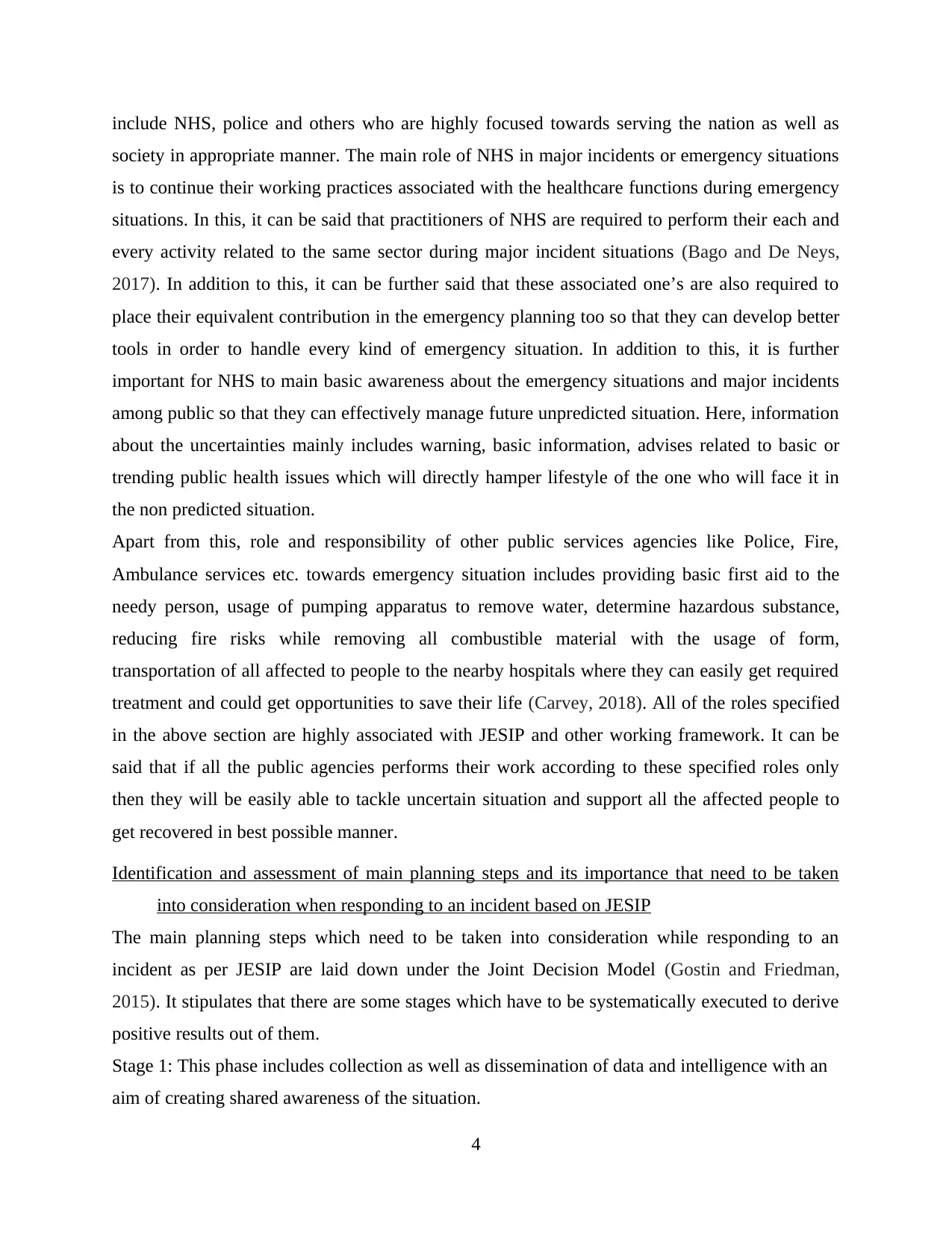
include NHS, police and others who are highly focused towards serving the nation as well as
society in appropriate manner. The main role of NHS in major incidents or emergency situations
is to continue their working practices associated with the healthcare functions during emergency
situations. In this, it can be said that practitioners of NHS are required to perform their each and
every activity related to the same sector during major incident situations (Bago and De Neys,
2017). In addition to this, it can be further said that these associated one’s are also required to
place their equivalent contribution in the emergency planning too so that they can develop better
tools in order to handle every kind of emergency situation. In addition to this, it is further
important for NHS to main basic awareness about the emergency situations and major incidents
among public so that they can effectively manage future unpredicted situation. Here, information
about the uncertainties mainly includes warning, basic information, advises related to basic or
trending public health issues which will directly hamper lifestyle of the one who will face it in
the non predicted situation.
Apart from this, role and responsibility of other public services agencies like Police, Fire,
Ambulance services etc. towards emergency situation includes providing basic first aid to the
needy person, usage of pumping apparatus to remove water, determine hazardous substance,
reducing fire risks while removing all combustible material with the usage of form,
transportation of all affected to people to the nearby hospitals where they can easily get required
treatment and could get opportunities to save their life (Carvey, 2018). All of the roles specified
in the above section are highly associated with JESIP and other working framework. It can be
said that if all the public agencies performs their work according to these specified roles only
then they will be easily able to tackle uncertain situation and support all the affected people to
get recovered in best possible manner.
Identification and assessment of main planning steps and its importance that need to be taken
into consideration when responding to an incident based on JESIP
The main planning steps which need to be taken into consideration while responding to an
incident as per JESIP are laid down under the Joint Decision Model (Gostin and Friedman,
2015). It stipulates that there are some stages which have to be systematically executed to derive
positive results out of them.
Stage 1: This phase includes collection as well as dissemination of data and intelligence with an
aim of creating shared awareness of the situation.
4
society in appropriate manner. The main role of NHS in major incidents or emergency situations
is to continue their working practices associated with the healthcare functions during emergency
situations. In this, it can be said that practitioners of NHS are required to perform their each and
every activity related to the same sector during major incident situations (Bago and De Neys,
2017). In addition to this, it can be further said that these associated one’s are also required to
place their equivalent contribution in the emergency planning too so that they can develop better
tools in order to handle every kind of emergency situation. In addition to this, it is further
important for NHS to main basic awareness about the emergency situations and major incidents
among public so that they can effectively manage future unpredicted situation. Here, information
about the uncertainties mainly includes warning, basic information, advises related to basic or
trending public health issues which will directly hamper lifestyle of the one who will face it in
the non predicted situation.
Apart from this, role and responsibility of other public services agencies like Police, Fire,
Ambulance services etc. towards emergency situation includes providing basic first aid to the
needy person, usage of pumping apparatus to remove water, determine hazardous substance,
reducing fire risks while removing all combustible material with the usage of form,
transportation of all affected to people to the nearby hospitals where they can easily get required
treatment and could get opportunities to save their life (Carvey, 2018). All of the roles specified
in the above section are highly associated with JESIP and other working framework. It can be
said that if all the public agencies performs their work according to these specified roles only
then they will be easily able to tackle uncertain situation and support all the affected people to
get recovered in best possible manner.
Identification and assessment of main planning steps and its importance that need to be taken
into consideration when responding to an incident based on JESIP
The main planning steps which need to be taken into consideration while responding to an
incident as per JESIP are laid down under the Joint Decision Model (Gostin and Friedman,
2015). It stipulates that there are some stages which have to be systematically executed to derive
positive results out of them.
Stage 1: This phase includes collection as well as dissemination of data and intelligence with an
aim of creating shared awareness of the situation.
4
Paraphrase This Document
Need a fresh take? Get an instant paraphrase of this document with our AI Paraphraser
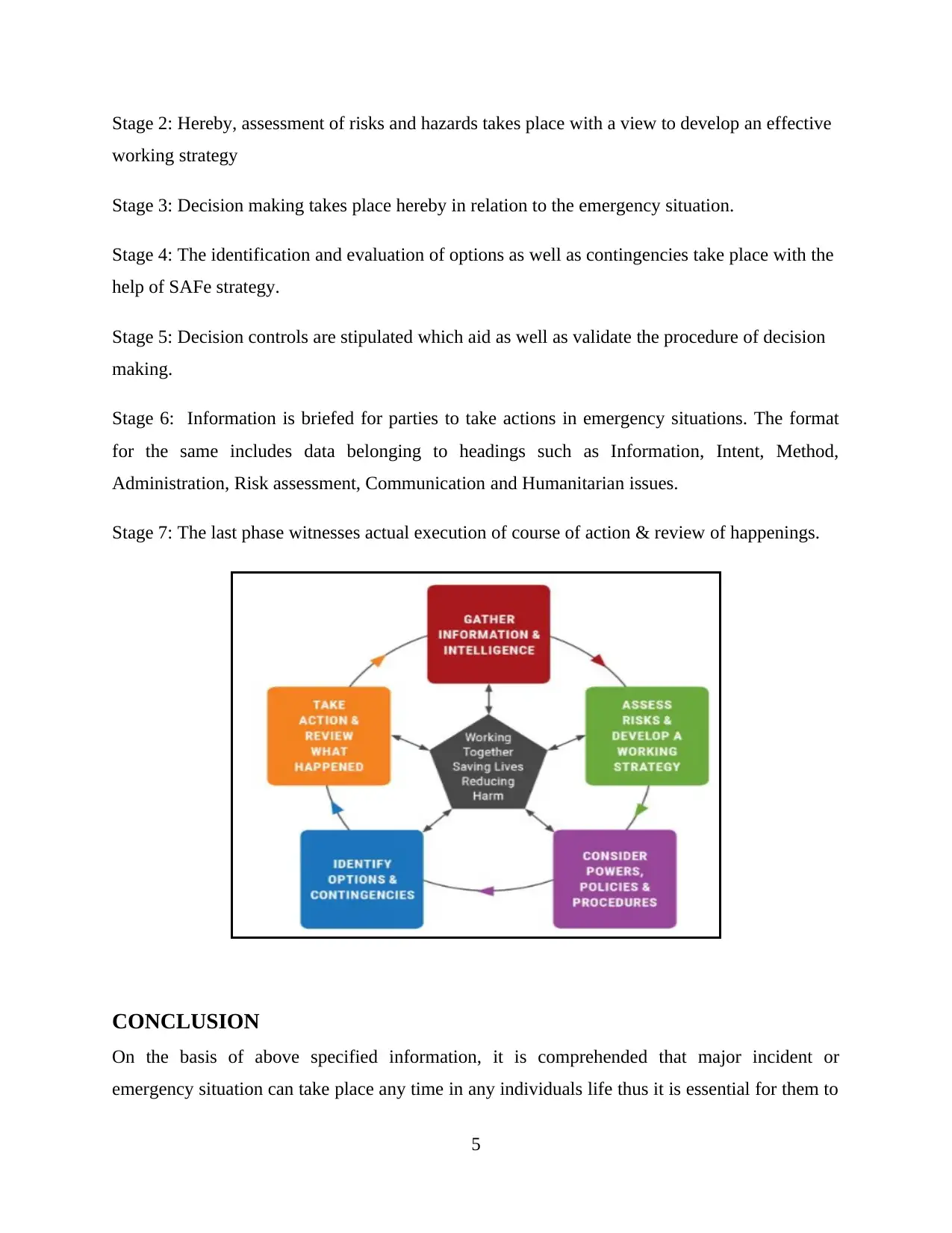
Stage 2: Hereby, assessment of risks and hazards takes place with a view to develop an effective
working strategy
Stage 3: Decision making takes place hereby in relation to the emergency situation.
Stage 4: The identification and evaluation of options as well as contingencies take place with the
help of SAFe strategy.
Stage 5: Decision controls are stipulated which aid as well as validate the procedure of decision
making.
Stage 6: Information is briefed for parties to take actions in emergency situations. The format
for the same includes data belonging to headings such as Information, Intent, Method,
Administration, Risk assessment, Communication and Humanitarian issues.
Stage 7: The last phase witnesses actual execution of course of action & review of happenings.
CONCLUSION
On the basis of above specified information, it is comprehended that major incident or
emergency situation can take place any time in any individuals life thus it is essential for them to
5
working strategy
Stage 3: Decision making takes place hereby in relation to the emergency situation.
Stage 4: The identification and evaluation of options as well as contingencies take place with the
help of SAFe strategy.
Stage 5: Decision controls are stipulated which aid as well as validate the procedure of decision
making.
Stage 6: Information is briefed for parties to take actions in emergency situations. The format
for the same includes data belonging to headings such as Information, Intent, Method,
Administration, Risk assessment, Communication and Humanitarian issues.
Stage 7: The last phase witnesses actual execution of course of action & review of happenings.
CONCLUSION
On the basis of above specified information, it is comprehended that major incident or
emergency situation can take place any time in any individuals life thus it is essential for them to
5

attain maximum possible information towards these situations and get prepared for it. Also, it has
been further acknowledged that The Civil Contingencies Act 2004 is best legislations for
emergency services which provide major contribution in coping up these issues and tackling
them in best possible manner.
6
been further acknowledged that The Civil Contingencies Act 2004 is best legislations for
emergency services which provide major contribution in coping up these issues and tackling
them in best possible manner.
6
⊘ This is a preview!⊘
Do you want full access?
Subscribe today to unlock all pages.

Trusted by 1+ million students worldwide

REFERENCES
Books and Journals
Ab Rahman, N. H. and Choo, K. K. R., 2015. A survey of information security incident handling
in the cloud. computers & security, 49, pp.45-69.
Giannakis, M. and Papadopoulos, T., 2016. Supply chain sustainability: A risk management
approach. International Journal of Production Economics, 171, pp.455-470.
Ford, J. D. and King, D., 2015. A framework for examining adaptation readiness. Mitigation and
Adaptation Strategies for Global Change, 20(4), pp.505-526.
Blossfeld, H. P., Rohwer, G. and Schneider, T., 2019. Event history analysis with Stata.
Routledge.
Papaioannou, G., Vasiliades, L. and Loukas, A., 2015. Multi-criteria analysis framework for
potential flood prone areas mapping. Water resources management, 29(2), pp.399-
418.
Einwiller, S. A. and Steilen, S., 2015. Handling complaints on social network sites–An analysis
of complaints and complaint responses on Facebook and Twitter pages of large US
companies. Public Relations Review, 41(2), pp.195-204.
Bago, B. and De Neys, W., 2017. Fast logic?: Examining the time course assumption of dual
process theory. Cognition, 158, pp.90-109.
Carvey, H., 2018. Windows forensic analysis DVD toolkit. Syngress.
Gostin, L. O. and Friedman, E. A., 2015. A retrospective and prospective analysis of the west
African Ebola virus disease epidemic: robust national health systems at the
foundation and an empowered WHO at the apex. The Lancet, 385(9980), pp.1902-
1909.
Peerally, M. F. and et. al., 2017. The problem with root cause analysis. BMJ quality &
safety, 26(5), pp.417-422.
Online
Roles and responsibilities of emergency responders. 2020. [Online]. Available Through:
<https://www.argyll-bute.gov.uk/roles-and-responsibilities-emergency-responders>.
7
Books and Journals
Ab Rahman, N. H. and Choo, K. K. R., 2015. A survey of information security incident handling
in the cloud. computers & security, 49, pp.45-69.
Giannakis, M. and Papadopoulos, T., 2016. Supply chain sustainability: A risk management
approach. International Journal of Production Economics, 171, pp.455-470.
Ford, J. D. and King, D., 2015. A framework for examining adaptation readiness. Mitigation and
Adaptation Strategies for Global Change, 20(4), pp.505-526.
Blossfeld, H. P., Rohwer, G. and Schneider, T., 2019. Event history analysis with Stata.
Routledge.
Papaioannou, G., Vasiliades, L. and Loukas, A., 2015. Multi-criteria analysis framework for
potential flood prone areas mapping. Water resources management, 29(2), pp.399-
418.
Einwiller, S. A. and Steilen, S., 2015. Handling complaints on social network sites–An analysis
of complaints and complaint responses on Facebook and Twitter pages of large US
companies. Public Relations Review, 41(2), pp.195-204.
Bago, B. and De Neys, W., 2017. Fast logic?: Examining the time course assumption of dual
process theory. Cognition, 158, pp.90-109.
Carvey, H., 2018. Windows forensic analysis DVD toolkit. Syngress.
Gostin, L. O. and Friedman, E. A., 2015. A retrospective and prospective analysis of the west
African Ebola virus disease epidemic: robust national health systems at the
foundation and an empowered WHO at the apex. The Lancet, 385(9980), pp.1902-
1909.
Peerally, M. F. and et. al., 2017. The problem with root cause analysis. BMJ quality &
safety, 26(5), pp.417-422.
Online
Roles and responsibilities of emergency responders. 2020. [Online]. Available Through:
<https://www.argyll-bute.gov.uk/roles-and-responsibilities-emergency-responders>.
7
1 out of 10
Related Documents
Your All-in-One AI-Powered Toolkit for Academic Success.
+13062052269
info@desklib.com
Available 24*7 on WhatsApp / Email
![[object Object]](/_next/static/media/star-bottom.7253800d.svg)
Unlock your academic potential
Copyright © 2020–2025 A2Z Services. All Rights Reserved. Developed and managed by ZUCOL.





